Author R.O. Kwon’s Guide to Seoul — Where She Loves to Eat, Drink, and Shop
Over the past few years, Korean culture has been captivating every corner of the globe. Here's how Korean-born author R.O. Kwon visits her home city.
Here’s a long-held belief I’ve kept private for decades, as it’s the kind of opinion that can start a bar fight: Seoul might be the most stunning city in the world. Not all people will agree; it’s the city of my birth, so I am, perhaps, a little biased. And yet, this spring, I was there, walking along the city wall, which was first built in 1396, and gazing at the jumbled skyline. It’s a gloriously chaotic tumult of tall, shining buildings and tiled hanok roofs, all of it surrounded by mountains. Cherry trees had burst forth, a frothing revel of short-lived blossoms. Wind stirred the boughs, lace-pink petals nodding as though saying yes to my renewed faith: there isn’t a more beautiful place to be on earth.
Even if you don’t quite agree with my no-longer-secret fighting words about Seoul, it’s indisputable that many people — Koreans, travelers from abroad, and diasporic Koreans like me — consider Seoul to be an especially thrilling city to visit these days, a hub of food, art, film, television, literature, beauty, and fashion. Some of this, of course, is driven by the Korean cultural wave that has swept the globe: the massive popularity of BTS, Blackpink, Squid Game, Parasite, so much K-pop and so many K-dramas. But a lot of the energy in Seoul comes not just from what is being exported out of South Korea but also from the things that can’t be experienced anywhere else.
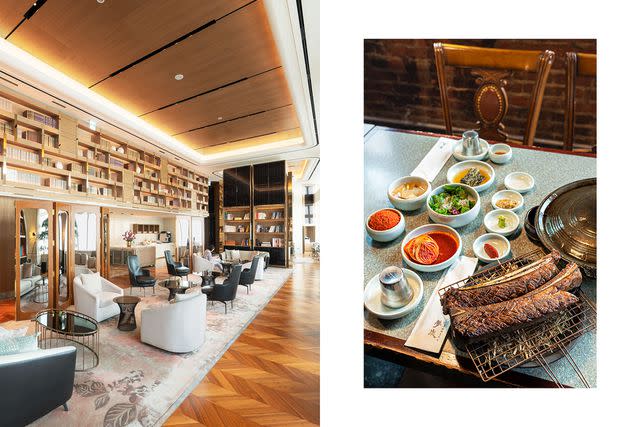
Youngkyu Park
From left: The guests-only lounge at the Signiel Seoul; udae galbi, or beef ribs, at the popular Mongtan barbecue restaurant.So, joining this flood of visitors, I went back to my birthplace. Excited as I felt, I was also fretful. I left Seoul with my family when I was three; I grew up in Los Angeles, and today live in San Francisco. Ever since my first trip back, when I was 12, I’ve felt vexed by the knowledge that I’m also foreign to Seoul. On a past trip, I flushed each time a taxi driver noted that I was obviously not from there. How much shame do I bring to my ancestors by being a Korean person whose English is more fluent than the language they all spoke?
In one of the first taxis I took this time, though, the driver and I talked. There are many more gyopo, or diasporic Koreans, in Seoul these days, he said. He praised my Korean. “It’s not very good,” I said, ashamed again. “No, you’re fluent,” he said, being kind, and I teared up.
"Cherry trees had burst forth, a frothing revel of short-lived blossoms. Wind stirred the boughs, lace-pink petals nodding as though saying yes to my renewed faith: there isn’t a more beautiful place to be on earth."
Even so, I couldn’t help taking this anxiety with me into Mongtan, a wildly popular barbecue restaurant that opened in Yongsan in 2019. Would-be guests have to sign up for the waiting list, in person, on the day of the meal. Friends advised that I go early; accordingly, I showed up right after the doors opened at 10 a.m. I gave them my name, then went for a stroll along the city wall, with its aforementioned heart-stopping views, and when I got back my table was ready.
Mongtan was packed; though it was a weekday lunch, the place rang loud and festive, with a bottle of soju, beer, or wine at most tables. I requested the signature dish, udae kalbi, or beef rib. While the waiter cut the richly marbled meat, I tried a bite of each of the banchan, the dishes served on the side. It was some of the tastiest I’ve had, the frozen minced kimchi so good I wondered, for the first time in my kimchi-filled life, why kimchi sorbet isn’t a ubiquitous thing. I finished it, and asked for seconds. (In general, guests can always ask for seconds, thirds, and more of banchan; my people are not a moderate people.)
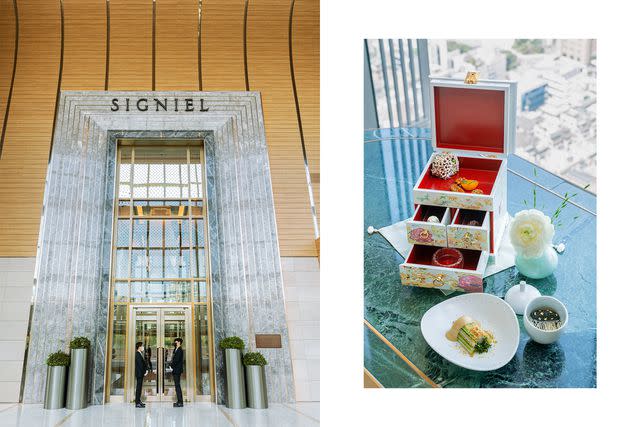
Youngkyu Park
From left: The entrance to the Signiel Seoul hotel at the base of Lotte World Tower; Eatanic Garden, a restaurant in the Josun Palace hotel, serves (clockwise from top) a box of sweets, smoked tofu topped with caviar, and fatsia shoots.I’d have left satisfied — no, delighted — by just the banchan, but now the rib was ready. The waiter told me which piece to eat, and when, and told me to accompany each bite with, in turn, the seaweed wasabi, pollack roe, and doenjang, a fermented soybean paste central to Korean cuisine. I was being ordered around, which made being at Mongtan feel not unlike eating with my often imperious elders; this felt calming. The kalbi was succulent. Since I am also not a moderate person, I asked for more kalbi. I ate it all.
I returned to my hotel, the gorgeous, Art Deco–inflected Josun Palace, which opened in 2021 in the stylish Gangnam district. Each time I walked into my room, the curtains swung wide automatically, revealing astonishing floor-to-ceiling views of Seoul. But after that lunch, I had to nap, so I shut them and lay down.
Related: The 15 Best City Hotels in Asia
Late that night, I still wasn’t ready for dinner, so I headed to some of Gangnam’s innovative cocktail bars. I talked about Seoul’s cocktail artistry with Solla Park, a bartender at Le Chamber, the first bar I visited. It’s a speakeasy hidden behind a small faux library; I fulfilled a lifelong fantasy by pushing a specified book to make the bookcase doors slide open. With its dark leather chairs and extensive whisky collection, my hidden-library fantasies continued to be fulfilled, but I was there for Le Chamber’s award-winning cocktails, one of which combined ginger beer fermented in-house, ginseng-infused vodka, pineapple, and lychee. Recently, Park was a national finalist in the World Class Cocktail Festival, dubbed the Oscars of bartending. “Participating in competitions is a good time to develop one’s skills,” she said. “If I do well, it feels as though I’m living up to the trust of the customers who visit Le Chamber.”
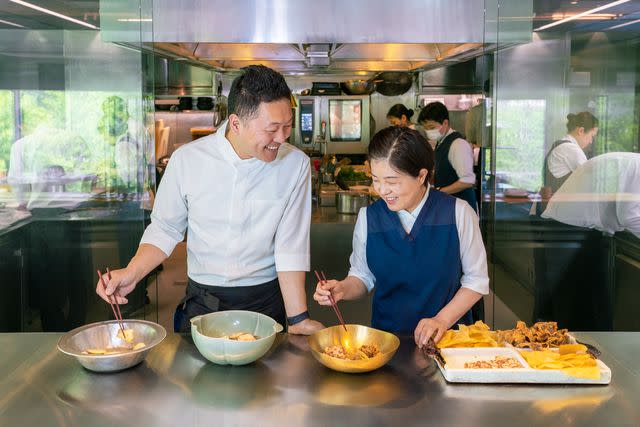
Youngkyu Park
Chefs Sung-bae Park (left) and Eun-hee Cho prepare bujak, or deep-fried vegetables, at their restaurant, Onjium.I walked down the block to Zest, a bar known for making cocktails from locally sourced ingredients, as well as its focus on sustainability and reducing waste. The Men-Ge Mule I ordered was made with farm-to-glass soju distilled in the nearby city of Andong, where my father’s family is from. I talked about Andong with Danny Park, a bartender who lived in Arizona before returning to Seoul. Zest’s drinks, he said, sometimes spring from trying out one ingredient with another, and just seeing what happens. This approach resulted in the most intriguing mule of my life; I told him this and he smiled, not surprised. Going home, I stopped at an all-night convenience store and bought a bag of shredded dried squid. It was a perfect, salty ending to the evening.
Dried squid was one of my favorite snacks when I was a kid, and more childhood memories were evoked at Eatanic Garden, a serene, newly Michelin-starred restaurant inside Josun Palace. The chef, Jongwon Son, uses ingredients from his childhood as the basis for his dishes, and the nine-course lunch kept startling me with exquisite combinations of flavors that reminded me both of my own upbringing and of nothing I’ve tasted before. My companion, a friend who is not Korean and hadn’t grown up with kimchi and doenjang as childhood staples, was just as delighted. One highlight that would stay with me long after I’d left was a dish of smoked tofu, fermented mushrooms, and caviar.
"In one of the first taxis I took this time, though, the driver and I talked. There are many more gyopo, or diasporic Koreans, in Seoul these days, he said. He praised my Korean. “It’s not very good,” I said, ashamed again. “No, you’re fluent,” he said, being kind, and I teared up. "
Son has worked in the venerated San Francisco restaurants Benu, Coi, and Quince, as well as Copenhagen’s Noma. “Chefs with experiences abroad are coming back to Korea and opening restaurants, using local ingredients and flavors,” he said. This is what I kept hearing: a lot of Koreans who’ve lived elsewhere are returning. They’re combining what they’ve learned in Korea and abroad, and the results are fascinating.
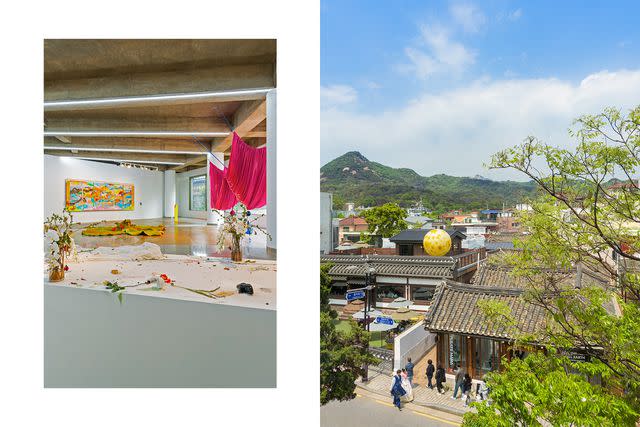
Youngkyu Park
From left: An installation by Boma Pak (foreground), a hanging fabric sculpture by Hannah Woo, and a painting by Rondi Park (on the far wall) at the Art Sonje Center gallery; northern Seoul, with Bukhansan National Park in the distance, as seen from the Art Sonje Center.After lunch, I took my suitcase to Signiel Seoul, a hotel inside Lotte World Tower, where I’d be staying for the rest of my time in the city. It’s the tallest building in South Korea, and I had a room on the 94th floor, which provided a bird’s-eye view of the city: its glittering skyscrapers, its highways and bridges like strings of jewels, and the Han River winding through it all like a broad, flexing ribbon.
It was a view I admired again from Signiel’s elegant, gray-toned sauna, which features a hot pool and a cold plunge pool. There is little on this earth as relaxing as jumping from hot water into a cold plunge, so I did this several times, my usually anxious brain falling, for once, quiet. I also got a massage, Signiel’s thorough aromatherapy body treatment; then, to relax more, I went across town for a facial.
I am, I’ll admit, a bit skeptical of facials. My own routine is involved enough that, I figure, there’s no need to pay others to put things on my face. But I was in Seoul, and, for a skin-care aficionado like me, Sulwhasoo’s serums, masks, and other creations are the ne plus ultra of Korean skin indulgence. A Sulwhasoo spa, then, might be considered a kind of pilgrimage site, if skin were holy, though I’d argue it sort of is, the body being a temple, and skin its largest organ…listen, what I’m saying is, I was very excited about my next stop. I asked for the ginseng-and-jade renewing treatment, which involved masks, jade applicators, and a massage, and was so relaxing I fell asleep twice.
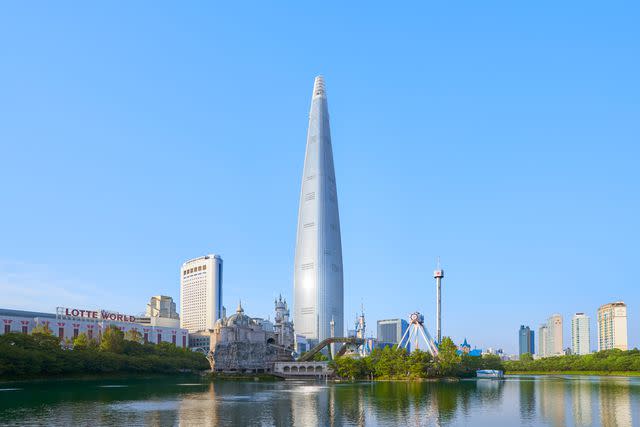
Youngkyu Park
The 123-story Lotte World Tower, home of the Signiel Seoul hotel, rises over Lotte World Magic Island, an amusement park.But more important, what did it do to my skin? It was so soft. I glowed as if the epidermal cells had transformed into tiny stars. I spoke to Eun Cho, at the front desk, about why people visiting Seoul might want to come to a Sulwhasoo spa versus the multitude of other options, and she put it down to the “special, dramatic before and after” effect. The spa relies on a combination of product and technique, based on both traditional Korean therapies and ongoing innovation. “We’re constantly educating ourselves,” she said.
Rigorous education and innovation are also central to the leadership of Onjium Restaurant, which has a Michelin star, and Onjium, a cultural research institute. Onjium is led by chefs Eun-hee Cho and Sung-bae Park; Cho is deeply versed in Korea’s culinary past. “Onjium researches traditional food by referring to passed-down literature, historical materials, and ancient cookbooks,” she said. “Then we find and showcase Korean food that has been forgotten in history.” It’s an education she and Park transform into inventions styled to appeal to contemporary palates, which resulted in some of the most fascinating, delicately original food I’ve come across. Onjium’s abalone juk, or porridge, was made with stir-fried abalone simmered at length with a sticky rice ball. It was a subtle, complex dish I’d love to eat every morning.
Related: This Hidden Modern Coffee Shop in Seoul Is Built Into a Traditional Korean 'Hanok'
After lunch at Onjium, I walked by the stone walls of Gyeongbokgung Palace, versions of which have stood on the site since 1395. I had plans to meet a friend, the Korean-American novelist Krys Lee, at a tea shop, Osulloc. She’s lived in Seoul for years, so I had asked her to help shape my itinerary. Over cups of green tea, Lee and I talked about how quickly Seoul is changing. Part of this dynamism comes from the characteristically Korean urge to put all the effort we can into what we do. Lee noted that Koreans tend not to just, say, set out to create outstanding pizza; one sets out to win pizza competitions in Italy. This is a recognizable impulse to me, one that can be both motivating and utterly exhausting. Included in this urge, in my experience, is a longing to do right by one’s people, to try to make us, as nebulous as that “us” might be, proud. By the same token, it is, perhaps, always possible to bring us shame. Lee and I laughed about this as we had tea that was delicious and, well, prize-winning.
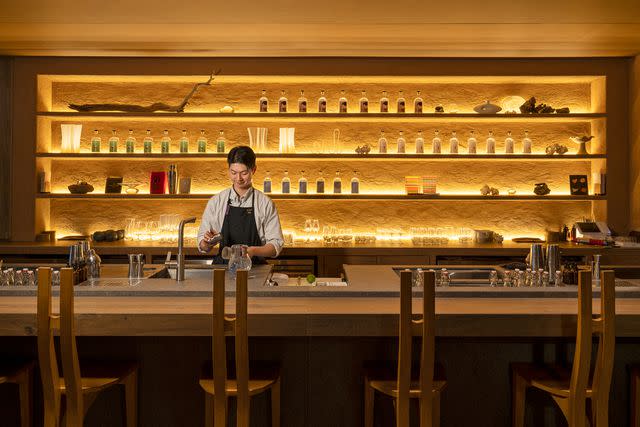
Youngkyu Park
Mixologist Medhi Hong at Zest, a cocktail bar in the Gangnam neighborhood.I was in Bukchon, a neighborhood close to a number of Seoul’s leading Korean-owned art galleries and museums, so I walked through the winding, hanok-filled streets to stop by a few: Kukje Gallery, Museumhead, and the Art Sonje Center. At Art Sonje, a private museum, I spoke with assistant curator Sohyun Kim. Seoul is a “huge, growing hub” of contemporary art, with rising hype and international interest, she said. Last year, Seoul joined London, New York City, and Los Angeles as an annual location for the Frieze art fair. Kim, who has lived in Sydney and London, moved to South Korea a couple of years ago after noticing that a lot of international galleries were opening branches in the capital. Art Sonje focuses on young artists, and I was entranced by fabric-based sculptures by Hannah Woo, vivid works evocative of women’s bodies, orchids, and bats. I could joyfully have spent a week with Seoul’s art, but I was hungry again.
I stopped at nearby Gaeseong Mandu Koong, a restaurant in a traditional hanok where large, plump dumplings are prepared by hand. I ate more than I should, then went back to the hotel. Signiel is relatively far from the center of the city, a destination in its own right because of its views, but there’s another reason people might want very much to be in that part of town: Garak Market, which includes one of Seoul’s vast, splendid fish markets. Other markets, especially Noryangjin, are better known; Garak, less of a tourist destination, could be my favorite. A friend who lives in Korea, Arar Han, recommended going to Garak’s Stall A28 for its daegae, or snow crab, which was in season. I took with me a friend who doesn’t speak Korean. My plan was to pretend that I, too, didn’t speak Korean, in order to test whether Garak would be navigable for people like him.
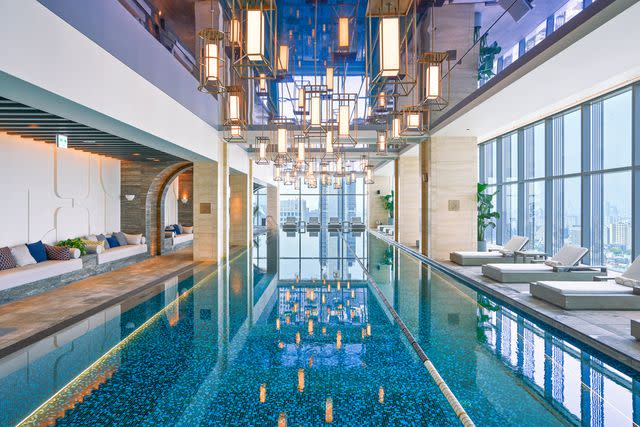
Youngkyu Park
The pool at the Josun Palace hotel.Despite the market’s size, the numbered stall was easy to find, and my friend pointed to the live crabs. One specimen was pulled from a tank, put in a bin, and sent up to the third floor as we followed behind, to a restaurant where the crab was going to be cooked for us. It was lunchtime, and the restaurant was busy. The steamed crab legs arrived. Once again, I was overwhelmed; I eat quite a bit of crab, yet this was the best I’ve ever tasted. My friend ordered soju; I remained silent. It was an acting job that fell apart when, as a staffer served us the drinks, she addressed me directly.
“You speak Korean, don’t you?” she asked, setting her hands on my shoulders. I had no poker face. My plan failed; I folded.
“I do! I had to conduct research!” I explained. She laughed, then brought out the final course, a fried rice made with the rest of the crab. It was rich and complex, with such depth and flavor that I found myself tearing up again. I knew that, the next time I was in Seoul, I’d come back to Garak just for this. May that be soon. I don’t live in Seoul, but it’s still, always, a kind of home.
R. O. Kwon’s Seoul
Where to Stay
Josun Palace: Opened in Gangnam in 2021, this Art Deco–style hotel, a member of the Luxury Collection, has 254 refined rooms and suites.
Signiel Seoul: For striking views, you can’t beat this 235-room Gangnam hotel, which extends from the 87th to the 101st floor of Lotte World Tower, South Korea’s tallest building. Stay, the hotel’s French restaurant, might make the softest, creamiest eggs I’ve ever eaten.
Where to Eat and Drink
Eatanic Garden: With its jade hues and central moss island, this Michelin-starred restaurant on the 36th floor of Josun Palace brings to mind a tranquil garden. The kitchen serves ethereal, reinvented Korean food.
Gaeseong Mandu Koong: Big, plump Gaeseong-style dumplings have been prepared by hand, daily, for three generations at this traditional hanok in Jongno.
The Great Hong Yuan: This restaurant, also on the 36th floor of Josun Palace, serves high-end Chinese food, such as delicious, nuanced jjamppong, or spicy seafood noodle soup. Ask to sit by the windows for an expansive city view.
Le Chamber: Push a book to open a secret door and reveal this handsome speakeasy in Gangnam. If it’s not too busy, the bartenders will be glad to mix you a bespoke cocktail.
Mongtan: Expect a long wait at this buzzy barbecue restaurant in Yongsan, where udae galbi, or beef ribs, are seared over charcoal and straw and finished on a pot lid.
Onjium Restaurant: At this small Michelin-starred restaurant in Jongno, seasonal ingredients are used to craft dishes that have been reimagined after years of research. There’s gorgeous pottery on display, as well as an “inspiration room” downstairs where the chefs go for ideas.
Osulloc Tea House: This chain of modern teahouses serves hot and cold teas and desserts. It might be hectic, but you can get a cup to go. It also offers excellent gifts to take home.
Zest: This minimalist Gangnam bar is a sustainable, waste-reducing operation. Even the bar’s raw honey comes from urban beekeepers.
What to Do
Art Sonje Center: A private three-story art museum in Jongno with contemporary works from Korea and around the globe. The museum prioritizes the work of young artists.
City Wall: Stroll along any of the various sections of Seoul’s imposing fortress wall to escape the urban din.
Garak Wholesale Market: An extensive market in the Songpa area where you can buy seafood on the ground floor and have it sent to an upstairs restaurant to be cooked. As long as you don’t go during opening or closing time, it shouldn’t be too crowded.
Kukje Gallery: An art gallery in Samcheongdong committed to both showcasing acclaimed artists from abroad including Louise Bourgeois and Jenny Holzer—and educating international audiences in Korean art.
Leesle: A tiny, colorful store in Hongdae with contemporary hanbok clothing loved by K-pop stars.
Sulwhasoo Spa Lotte Hotel: This spa, from a celebrated skin-care brand, offers a range of face and body treatments. You’ll leave glowing and relaxed.
A version of this story first appeared in the August 2023 issue of Travel + Leisure under the headline "Heart And Seoul."
For more Travel & Leisure news, make sure to sign up for our newsletter!
Read the original article on Travel & Leisure.

